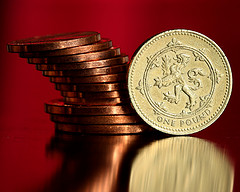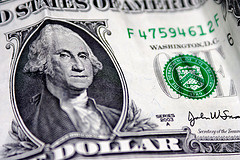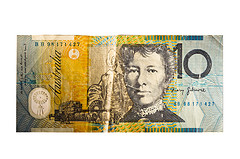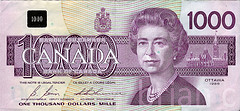1. Money money money
 Imagen de Tristan Martin en Flickr bajo licencia CC |
As the song goes:
"A mark, a yen, a buck, or a pound
A buck or a pound
A buck or a pound
Is all that makes the world go around,
That clinking clanking sound
Can make the world go 'round."
What currency would you use if you went to England? What about the Republic of Ireland? And Canada?
Let us review some of the currencies in English speaking countries.
Reflexión
 Imagen de c_ambler en Flickr bajo licencia CC |
 Imagen de Curtis Perry en Flickr bajo licencia CC |
British money is measured in pounds sterling and pence, though people mostly just say pounds and pence. 100 pence = 1 pound.
Currency is either written as 50GBP or £50, with coins less than £1 called pence or p. (50 pence = 50p)
Collectively, paper money is known as notes.
American money is divided into dollars and cents. 100 cents = 1 dollar.
Currency is either written as USD100 or $100, with coins less than 1 dollar called cents and written as 50¢.
Collectively, paper money is known as bills.
1-cent coin is called a penny.
5-cent coin is called a nickel.
10-cent coin is called a dime.
25-cent coin is called a quarter.
One Dollar is also known as a single.
Cash is a term money in general, as well as a way to pay. The question “Cash or credit?” means would you rather pay with actual money or on a credit/debit card?
Bucks is a plural slang term for dollars. “I paid 20 bucks for this shirt.”
Currency in Canada is also called dollars and cents. It is written as 1CAD, C$1 or $1.
Collectively, paper money is called bills.
In Canada, there is both a $1 coin and a $1 bill. The $1 coin is also called a loonie.
There is also a toonie (two loonies), which is a $2 coin.
In Australia, money is divided into dollars and cents.
Collectively, Australian dollars are called notes.
Australian bills, in slang, are referenced by their colors. A ten dollar note is called a blue-tongue because the note is mostly blue.
A twenty-dollar note is known as a lobster because the note is mostly red.
A fifty-dollar note is called a pineapple because the note is mostly yellow.
However, a one-hundred-dollar note is known as a hundi-stick.
New Zealand currency is divided into dollars and cents.
Collectively, New Zealand dollars are called notes. It is written as 50NZD, NZ$50 or $50.
The New Zealand dollar is also called the kiwi.
New Zealanders also call their money dosh.
Source: http://kaplaninternational.com/blog/quick-english-money-talks/
After reading the text, answer the following questions:
- In which countries is the currency divided into dollars and cents?
- Where is paper money called notes?
- In which country is there a coin called a nickel? How much is it worth?
- Where are notes referenced by their colors?
- In which country is the currency given the name of a fruit?
Conocimiento previo
 Imagen de Brian nairB en Flickr bajo licencia CC Imagen de Brian nairB en Flickr bajo licencia CC |
Did you know that Queen Elizabeth II appears on Canadian dollar bills? Why do you think that is?
Elizabeth II is the constitutional monarch of 16 sovereign states, known as the Commonwealth realms, and their territories and dependencies, and head of the 53-member Commonwealth of Nations (the Commonwealth of Nations is an intergovernmental organisation of 53 member states that were mostly territories of the former British Empire). She is Supreme Governor of the Church of England and, in some of her realms, carries the additional title of Defender of the Faith.
Upon her accession on 6 February 1952, Elizabeth became Head of the Commonwealth and queen regnant of seven independent Commonwealth countries: the United Kingdom, Canada, Australia, New Zealand, South Africa, Pakistan and Ceylon. From 1956 to 1992, the number of her realms varied as territories gained independence and some realms became republics. At present, in addition to the first four of the aforementioned countries, Elizabeth is Queen of Jamaica, Barbados, the Bahamas, Grenada, Papua New Guinea, the Solomon Islands, Tuvalu, Saint Lucia, Saint Vincent and the Grenadines, Belize, Antigua and Barbuda, and Saint Kitts and Nevis.
Source: http://en.wikipedia.org/wiki/Elizabeth_II
Have a look at this site where you will see different notes from different countries with Queen Elizabeth on them.